Country research: Kenya
Homepage " Country research " Africa " Kenya
Kenya
Subpages:
(No subpages yet)
The content reflects the results of Perplexity's research and analysis and does not represent an expression of opinion by Gradido. They are intended to provide information and stimulate further discussion.
Kenya, Gradido, Open Source & Ubuntu - How Africa can pave the way for global prosperity, peace and freedom
Kenya is considered one of the most dynamic countries in Africa, leading the way for the entire continent with innovation, active civil society and community-based values. This research report shows how Kenya's social, economic, cultural and technological starting point creates ideal conditions for bottom-up economic and community transformation, with a particular focus on Gradido, open source technologies and Ubuntu-based structures. The great potential of this African model for global prosperity, peace and freedom in harmony with nature is illustrated using clear analyses, graphics and inspiring practical examples.
1. social, economic and political situation in Kenya
1.1 Economic growth and structural challenges
Kenya has recorded robust economic growth for years (2024: around 5%, well above the average for sub-Saharan Africa). The country has established itself as the most important business location in East Africa, with a dynamic service sector, growing industry and innovative financial solutions. Nevertheless, the social divide remains pronounced: income and resources are very unevenly distributed both regionally and socially, with poverty dominating in the north in particular, while urban regions such as Nairobi are benefiting from dynamic innovation and a growing middle class.^1^3
Youth unemployment is high and represents one of the greatest challenges facing society. Around 800,000 young people enter the labor market every year, but only around 200,000 new jobs are created, which means massive challenges for the prospects and participation of young people. However, this generation is also the driving force behind technological innovations and social movements that are transforming the country.^4^6^1

City skyline with high-rise buildings during sunset or sunrise
1.2 Social challenges and areas of tension
Social problems such as unemployment, rural exodus, ethnic tensions, corruption and unequal access to education and health continue to characterize the country. Corruption costs Kenya an estimated 15 million euros a day and undermines trust in state institutions. At the same time, protests and civil society engagement show that the population is increasingly demanding accountability.^4^9^11^13
Urbanization is advancing rapidly, fostering innovation and social movements on the one hand and new forms of urban poverty and social exclusion on the other. Around 60% of the urban population live in informal settlements where basic infrastructure and services are lacking.^14
1.3 Political transformation and civil society participation
Politically, Kenya is more stable than many neighbouring countries, but political transformation is often associated with protests and democratic engagement, especially by youth organizations and civil society groups. Civil society participation is growing, especially in major cities, where critical networks are increasingly driving innovation and new forms of social action. The 2024 and 2025 protests against tax increases and for more transparency show the increasing political maturity and mobilization capacity of Kenyan society.^1^12^15^17
2. role of community, Ubuntu and cultural strengths
2.1 Ubuntu as a philosophy of life and social practice
Ubuntu, the traditional African principle of „I am because we are“, deeply characterizes Kenya's community life. This philosophy emphasizes the interdependence and responsibility of all members of a community and forms the foundation for solidarity-based action. Solidarity action, neighborhood networks, resource-based self-help groups and women's cooperatives form the backbone of social support.^18^20^22^24^26^28
In both rural and urban contexts, families and neighborhoods are central actors for provisioning, care work and collective problem-solving. The Ubuntu principle manifests itself in various everyday practices such as chamas (informal savings and credit groups), collective farming projects and community childcare systems.^23^26^29
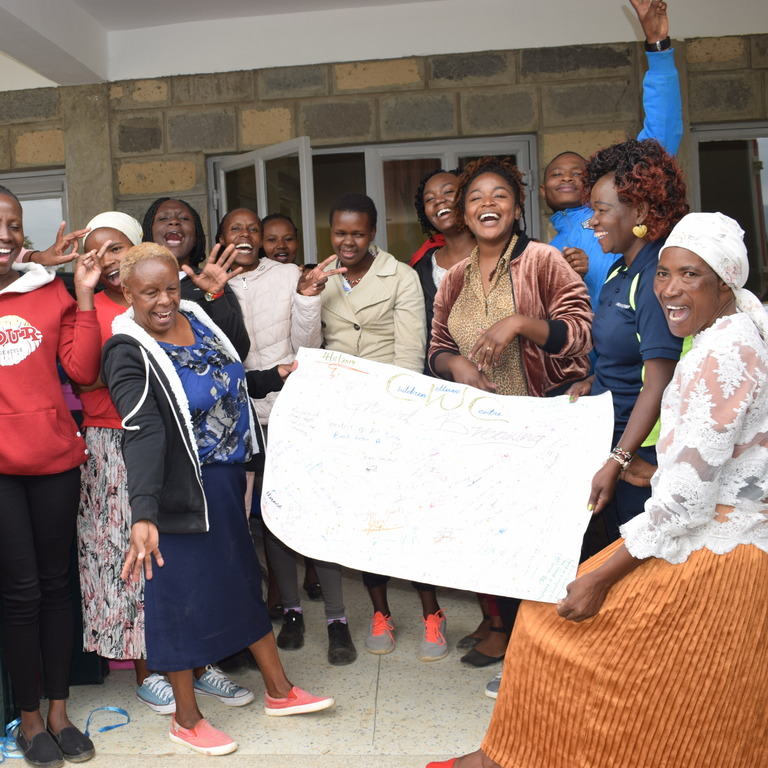
A group of women engaged in community work, holding a collaborative poster illustrating collective efforts inspired by Ubuntu values in Kenya.
2.2 The central role of women in community structures
Women play a key role, both as providers of care work and as initiators of local projects and self-help groups. Initiatives such as the St. Monica Widows' Cooperative or Ubuntu Maai Mahiu create jobs, social security and community transformation. These projects impressively demonstrate how women achieve economic autonomy through collective organization and at the same time strengthen social networks.^25^27^31
Care work, traditionally performed by women, is increasingly recognized as an indispensable contribution to society. Ubuntu initiatives are working to make this work visible and honor it, while at the same time developing new models of gender-equitable division of labor.^23^32

Women and community members collaborating around a sewing machine in an outdoor Kenyan setting, illustrating communal empowerment and skill sharing.
2.3 Openness to transformation and innovation
Society is increasingly open to participatory transformation and innovative forms of coexistence. Role models such as the Ubuntu community and local empowerment projects are creating solidarity and social change. Particularly noteworthy is the combination of traditional values with modern technologies and forms of organization, which creates a unique dynamic of innovation.^19^22^34^36^38
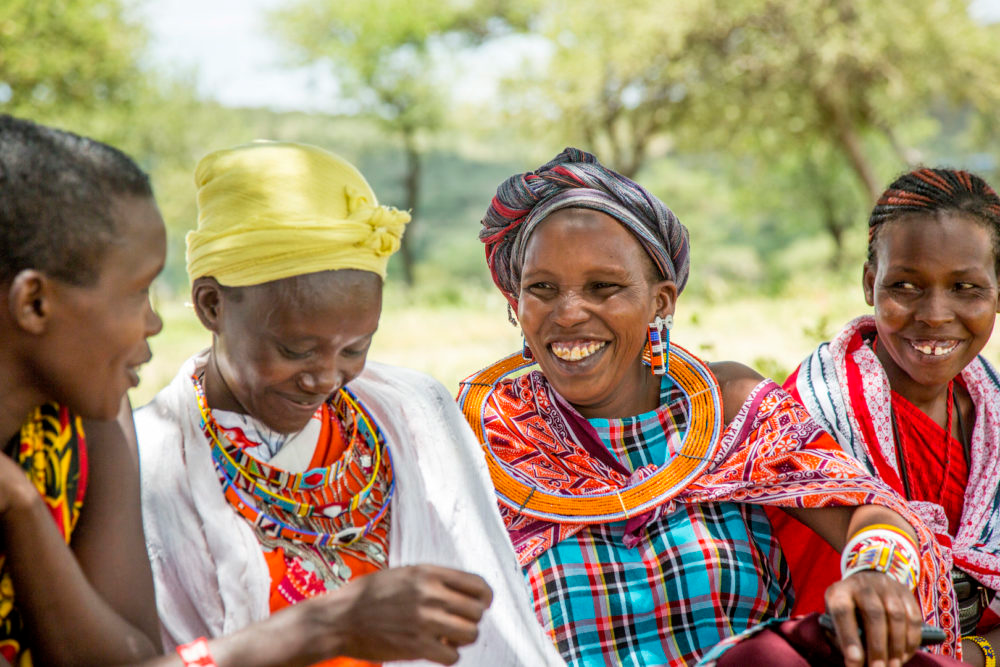
Kenyan women dressed in traditional attire illustrating communal bonds and cultural heritage linked to Ubuntu values.
3. digitalization, open source & innovation dynamics in Kenya
3.1 Silicon Savannah - Nairobi's tech ecosystem
Nairobi is now known as „Silicon Savannah“ - a vibrant hotspot for digital innovation, with over 150 tech start-ups, numerous hubs and a unique start-up ecosystem. The city has established itself as Africa's leading tech hub, attracting international investment and talent from across the continent. M-Pesa's success story revolutionized the financial world: mobile payment solutions provide 51 million Kenyans with access to financial services and have created 180,000 direct jobs.^3^40^42
Tech hubs such as iHub, Nailab and Gearbox foster a broadly networked developer community, with targeted programs for female founders, EdTech and peer mentoring. The iHub was founded in 2010 and has become one of Africa's most influential innovation hubs, with over 16,000 members and numerous successful start-up spin-offs.^37^43
3.2 Key initiatives and players
Initiatives such as Moringa School, She Code Africa and Grassroots Economics are driving bottom-up innovation into rural areas. Moringa School 2025 has launched an ambitious programme to provide 3,600 Kenyan youth with free AI skills, with a particular focus on marginalized groups. She Code Africa specifically empowers women in the tech sector through mentoring, workshops and networking.^6^44^46^48
Grassroots Economics combines technological innovation with social inclusion and develops community currencies that strengthen local economic cycles. This organization is an example of how open source technology and community empowerment can work together.^49^51^53
3.3 Open source as a driver of inclusive development
Open source and social innovation projects in particular are at the heart of the digital transformation. Partnerships with OSBA (Open Source Business Alliance), digital innovation hubs and transcontinental programs contribute to the emergence of a collaborative, inclusive ecosystem. The open source community in Kenya is growing steadily and offers young developers in particular access to global networks and learning resources.^6^37^56
The Kenyan open source ecosystem is characterized by a strong grassroots orientation in which local needs determine the development of technologies. Projects such as Ushahidi, an open source platform for crisis management and citizen participation, have gained international recognition and demonstrate the potential of Kenyan innovations for global challenges.^7^43^56
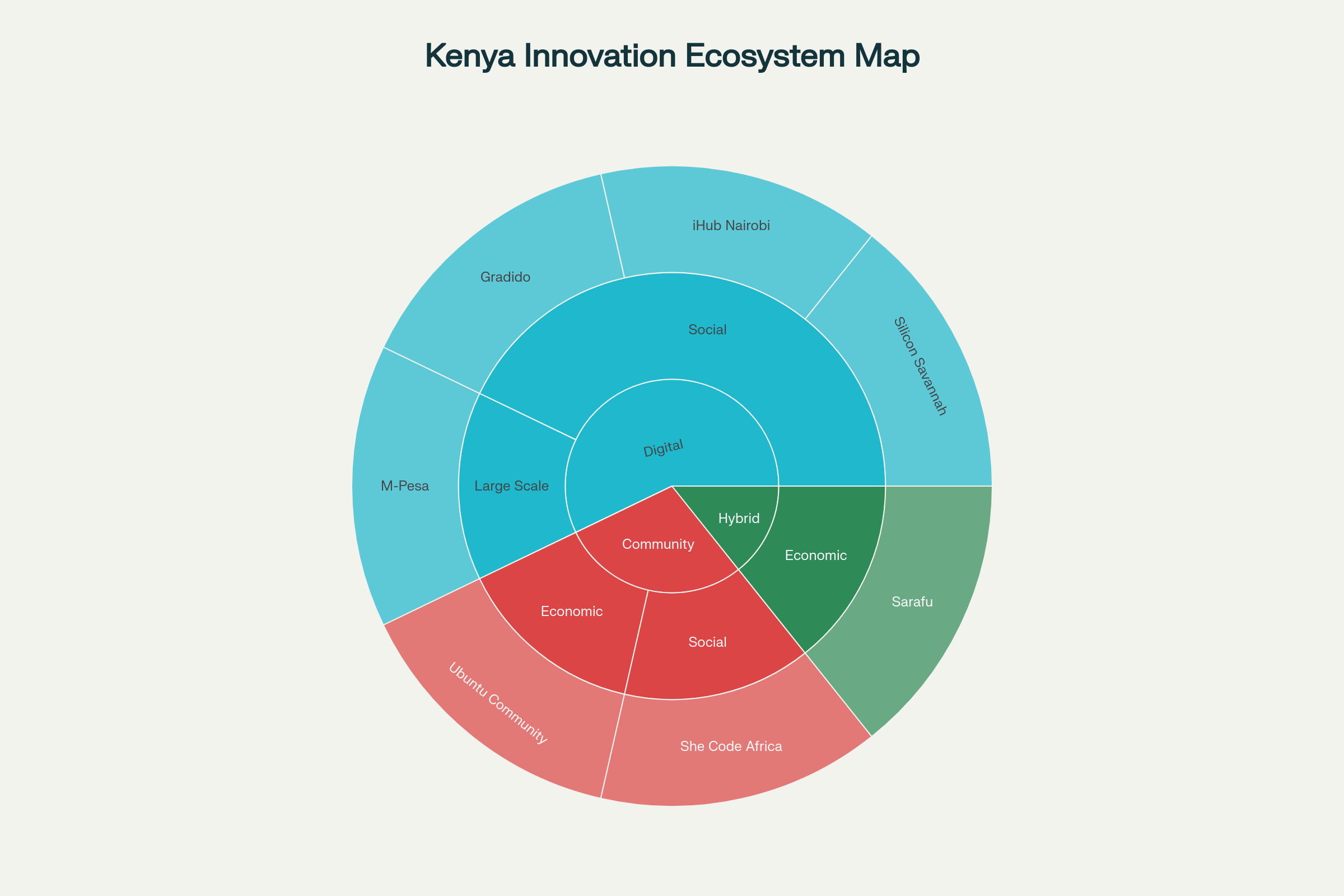
Overview: Key innovations, community currencies and social initiatives in Kenya
4. regional economic cycles, community currencies & role models for Gradido
4.1 Sarafu - pioneering work for community currencies
Kenya has been successfully experimenting for years with community currencies such as Sarafu (Grassroots Economics), which boost local economic cycles and create income opportunities. The Sarafu credit enables 22% to generate more income for participating small businesses, promotes local trust and can also be used without the internet via USSD.^49^51^53^59^61
The Sarafu system was originally introduced in 2017 as a paper money-based community currency and migrated to a digital blockchain-based platform in 2019. Over 56,000 users in informal settlements use Sarafu for everyday transactions, from grocery shopping to school fees.^50^53^58
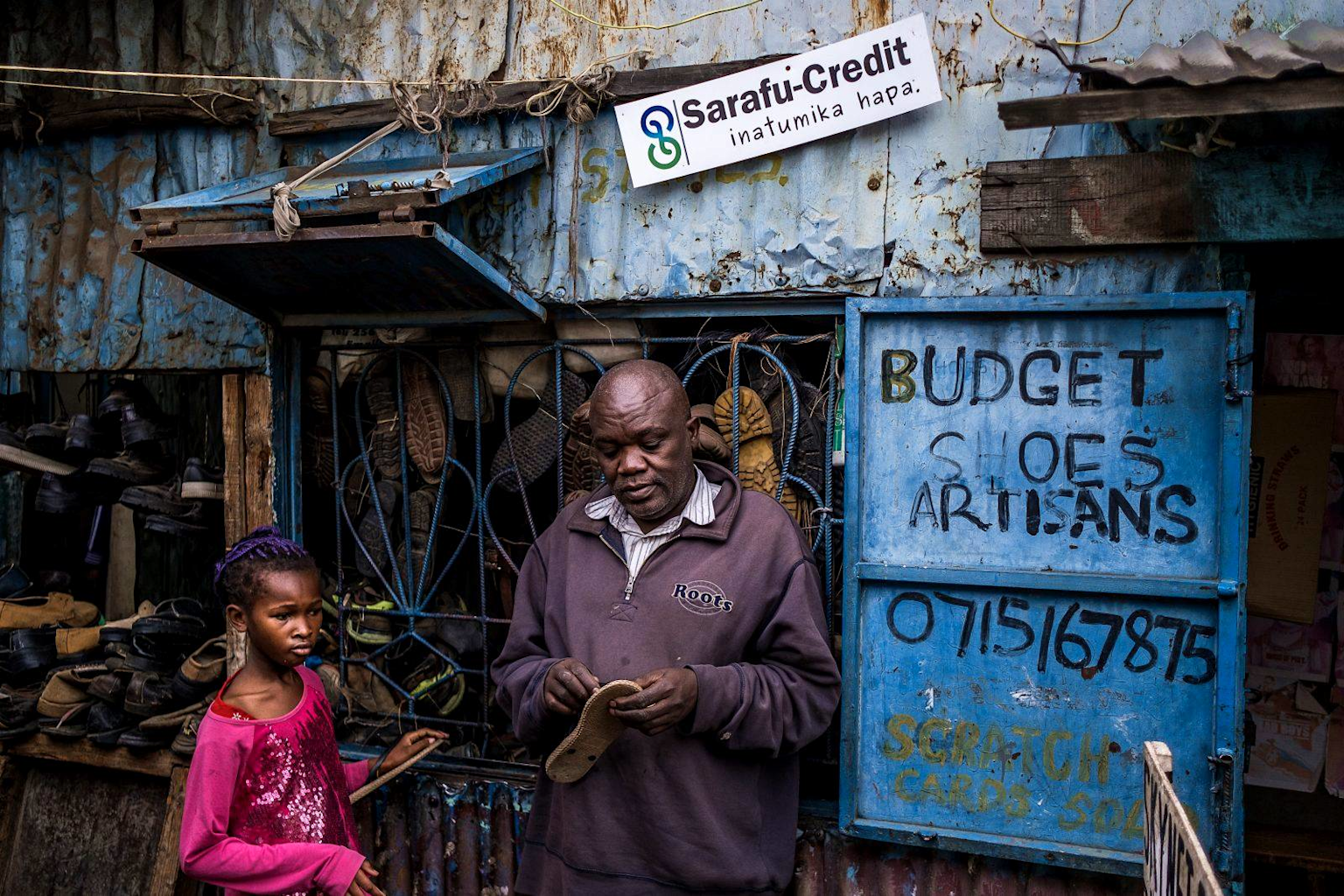
Sarafu community currency accepted at a local shoe artisan store in Kenya supporting grassroots economic activity.
4.2 Community Inclusion Currency (CIC) - An innovative model
Grassroots Economics has developed a Community Inclusion Currency (CIC) model that empowers informal sectors and marginalized groups in particular, using blockchain technology and monitoring via digital platforms. The CIC model is based on the principle of mutual lending within a community, whereby the currency is backed by the goods and services of the participants.^49^52^54
A study from 2022 showed significant positive effects: Households that used Sarafu were able to increase their income by an average of 22%, food security improved by 14%, and social networking within the communities increased measurably. It is particularly noteworthy that 60% of the users are women, who often have no access to traditional banking services.^51
4.3 Lessons learned and success factors
Lessons learned from pilot projects show that the promotion of community currencies is particularly effective where traditional banking services are ineffective and social networks support the economy. Success factors include:^49^58
Trust through personal relationshipsChamas and existing neighborhood networks form the basis for the acceptance of new currency systems.^30^53
Technological accessibilityUsability via simple cell phones (USSD) enables broad participation even without smartphones or the Internet.^53^58
Community governanceLocal communities decide on rules and applications themselves, which promotes ownership and sustainability.^51^49
Monitoring and transparencyBlockchain-based systems enable transparent transaction histories and create trust.^52^51
Hybrid approachesThe combination of digital and analog elements (e.g. paper vouchers as a backup) increases resilience.^50^49
4.4 Attitude towards alternative economic models
The attitude towards new, community-based economic models such as Gradido is generally positive in Kenya, especially among civil society actors and in informal sectors. The successful experience with Sarafu has shown that alternative currency systems work and can create real added value. At the same time, there is also resistance and challenges:^49^51^60
Opportunities:
High acceptance of innovative financial solutions thanks to M-Pesa's success^3
Strong grassroots movements and civil society organizations^6^37
Openness to experimental approaches in informal sectors^50^62
Need for inclusive economic models due to high unemployment^4
Resistors:
Skepticism from banks and established financial institutions^3
Regulatory uncertainties and lack of a legal framework^10
Limited digital infrastructure in rural areas^57
5. promotion of women, training & empowerment
5.1 Women in the tech sector - initiatives and programs
The advancement of women in the tech sector is steadily gaining momentum in Kenya: Initiatives such as Women In Tech Kenya, She Code Africa and MentorMe are empowering girls and women in STEM and leadership. Women In Tech Kenya is a global movement with a strong local presence that supports women through networking, mentoring and skill-building.^25^31^47^65
Bootcamps, peer learning, mentoring and targeted visibility have contributed to a growing number of successful tech role models that are inspiring not only Kenya but the whole of Africa. The iHub has launched the Mastercard Foundation EdTech Fellowship, a program where 75% of the participants are female EdTech innovators.^43^45^47^64
5.2 Educational pathways and empowerment formats
Successful educational paths and empowerment formats include:
Coding BootcampsMoringa School offers intensive 12-20 week programs in software development, data science and product management. The school has now trained over 3,000 graduates, with targeted scholarships for women.^45
Peer learning networksShe Code Africa organizes regular meetups, hackathons and mentoring sessions that allow women to network and learn from each other.^44^48
Transcontinental mentoring programsThe German-Kenyan mentoring program of B.A.U.M. e.V. and BMZ connects Kenyan female entrepreneurs with German mentors and creates intercultural learning spaces.^64
Community-based trainingLocal organizations such as WeCare offer low-threshold training in craft and agricultural areas, combined with digital skills.^30^67
5.3 Best practice and inspiring role models
Best practice examples show the variety of successful approaches:
AkiraChixThis organization trains young women in IT professions and then places them in tech jobs, with a placement rate of over 80%.^43
Likoni Women Hope & EcoThis project combines environmental protection with women's empowerment by training women in sustainable business models and promoting ecological regeneration at the same time.^68
St. Monica Widows' CooperativeA self-help initiative that offers widows economic prospects through collective farming and handicrafts.^31
Inspiring tech role models such as the founders of Kenyan EdTech start-ups, female lead developers in international tech companies and community organizers show young girls that tech careers are achievable. This visibility is crucial to breaking down stereotypical gender roles and inspiring more women to pursue STEM careers.^44^47^43
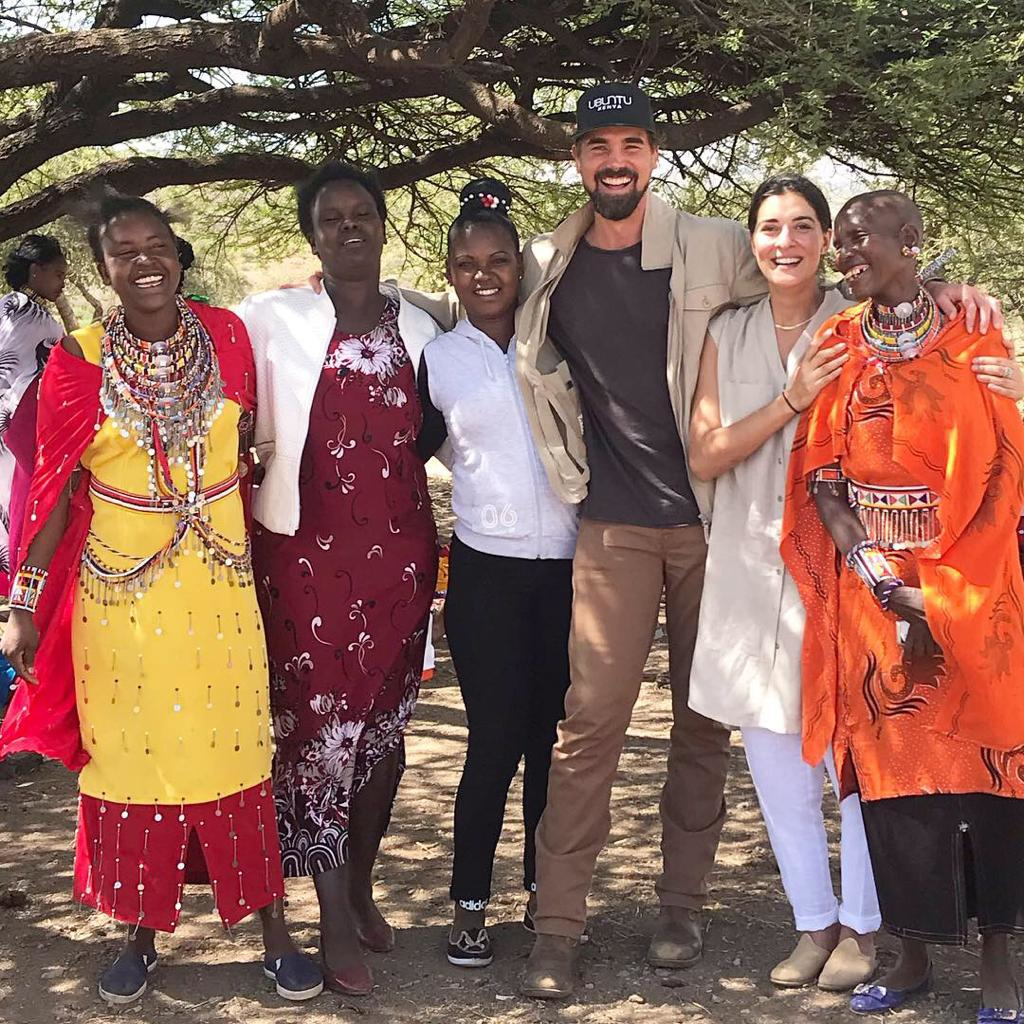
Kenyan community members blending traditional Maasai attire with modern styles under a communal tree, reflecting cultural heritage and social unity.
6 Gradido, Ubuntu and Open Source - opportunities, synergies and next steps
6.1 Gradido principles and their connectivity in Kenya
The Gradido principles - triple happiness (people, community, nature), Debt-free, decentralized money creation and ecological balance - are particularly relevant to Kenyan society. The principle of the threefold good resonates strongly with the Ubuntu philosophy, which also emphasizes the good of the community and harmony with nature.^19^69^71^73^75
Gradido is based on the idea of the „natural economy of life“, which is inspired by biological cycles: growth and decay, giving and taking, abundance and balance. The system envisages that money is not created through debt, but through active participation in the common good.^69^71^73^75
Core principles of Gradido:
Active basic income: Every person can earn Gradido through activities for the common good, which are confirmed by the community.^73^75
Triple money creationFor every creation of Gradido, one third is created as an unconditional basic income, one third for the state budget and one third for the equalization and environmental fund.^70^69
Planned transience50% of the balance passes per year (approx. 5% per month), which promotes a continuous flow of money and prevents hoarding.^71^75
Decentralized communitiesLocal groups organize themselves and confirm each other's contributions to the common good.^77^79^81
6.2 Synergies between Gradido, Ubuntu and Open Source
In decentralized communities, common good points are awarded and common good work is remunerated as a basis for modelling alternative regional currencies. Gradido can develop its strengths primarily in the areas of community organization, peer-based value creation and active participation.^69^76^81^83^85
Synergies arise through:
Ubuntu as a cultural frameworkThe Ubuntu philosophy provides the cultural and social basis for community-based economic models.^19^22^24
Open source as a technological infrastructureGradido is available as open source software, which enables transparency, participation and local customization.^77^86
Sarafu as a basis for experienceThe successful pilot projects with Sarafu show that community currencies work in Kenya and provide valuable lessons learned.^49^51^54
Tech ecosystem as a multiplierThe vibrant tech ecosystem with its hubs, developers and innovators can drive the technical implementation and scaling of Gradido applications.^37^40^55
Synergies arise from the fusion of open digital tools, traditional Ubuntu culture and Gradido applications.^70^81^87^69
6.3 Concrete applications and pilot projects
Digital networking, apps and platforms (Gradido account, DankBar, community circles) provide the framework for scalable, sustainable prosperity promotion and participatory poverty alleviation.^78^81^88
Concrete fields of application in Kenya:
Making care work visible and remunerating itWomen who perform care work could experience appreciation and economic recognition through Gradido community wellbeing points.^23^33^90
Promoting educational initiativesPeer learning, mentoring and community education projects could be financed and incentivized via Gradido.^73^92
Rewarding environmental protectionReforestation projects, waste collection, sustainable agriculture and water conservation could be supported by the compensation and environmental fund.^68^75
Strengthening local economic cyclesSimilar to Sarafu (also in cooperation), Gradido could network local markets and small businesses and build resilient regional economies.^50^83
Promoting digital innovationOpen source developers and tech initiatives could finance their work sustainably through Gradido remuneration.^55^86
Best practice examples from pilot regions show that community-based complementary currencies overcome social isolation and strengthen the feeling of being needed.^83^88
6.4 Next steps for implementation
Short-term steps (0-6 months):
Building partnerships with existing initiatives (Grassroots Economics, iHub, She Code Africa)^37^49
Organize workshops and information events on Gradido principles^92
Adapt technical infrastructure (USSD integration for feature phones)^49^58
Medium-term steps (6-18 months):
Launch of 5-10 pilot communities with 50-200 participants per community^51^81
Establishment of local coordination offices and support structures^37
Long-term steps (18+ months):
Integration with existing digital platforms (M-Pesa, etc.)^3
Policy work for legal recognition and framework conditions^17
7. economic cycles & self-empowerment - the path to self-sufficient gradido networks
7.1 Building functioning Gradido communities
Following the Kenyan model, functioning gradido communities and regional economic cycles could gradually emerge: The principle of peer-validated creation of common good points, the digital platform for local groups, and the connection to the Sarafu and Ubuntu community lay a sustainable infrastructure.^69^79^82
Success factors for self-sufficient networks:
Local anchoringCommunities are based on existing social networks (chamas, neighborhood groups, cooperatives)^25^28^49
Peer governanceDecisions are made democratically by community members^49^52
Diverse participation: All members can earn Gradido through different contributions (care, education, crafts, environment)^73^90
TransparencyBlockchain-based systems enable traceable transactions^51^54
Hybrid structuresCombination of digital and analog elements for broad accessibility^54^97^49
7.2 Software features and organizational models
Key software features include user-based value creation, community wallets, cross-community transactions and participatory governance structures.^77^81
Technical requirements:
Mobile-first approachOptimization for smartphones and feature phones (USSD)^3^53
Offline capabilityFunctionality even with unstable Internet^49
Multi-language support: Swahili, English and local languages^9
Community dashboardTransparent overview of transactions, balances and public welfare contributions^78^81
Peer validation systemSimple confirmation of community service by community members^73^92
Integration with existing systemsInterfaces to M-Pesa and other payment systems^40
Organizational models:
Hybrid governanceCombination of democratic self-administration and experience-based coordination roles^51^49
Network of networksAutonomous local communities that are networked via a meta-platform^80^77
Training hubsRegional centers for training, support and networking^37^92
Conflict resolution mechanismsCommunity-based mediation for disputes^16^99
7.3 Scaling and knowledge transfer
The know-how can be easily scaled up, while trainings of trainers and digital toolkits prepare for further expansion to other African countries. Gradido circles and community apps enable the self-confident, resilient organization of regional networks with potential for transcontinental impact.^77^89^94
Scaling strategies:
Modular trainingStandardized but adaptable training modules for different target groups^64^89
Digital learning platformsOnline resources, videos and tutorials in local languages^45
Peer-to-peer transferExperienced communities mentor new communities^65^94
Documentation of best practicesSystematic recording and dissemination of successful approaches^35^51^53
Transnational networksExchange between Kenyan and other African communities^36^96
Knowledge transfer to Africa:
Regional hubsEstablishment of Gradido competence centers in Nairobi, Lagos, Accra, Johannesburg^39^96
Pan-African ConferencesAnnual meetings to exchange experiences^96
Mobile training teams: Traveling trainers for remote regions^89
Digital CommonsOpen knowledge database with documentation, code and training materials^55^86
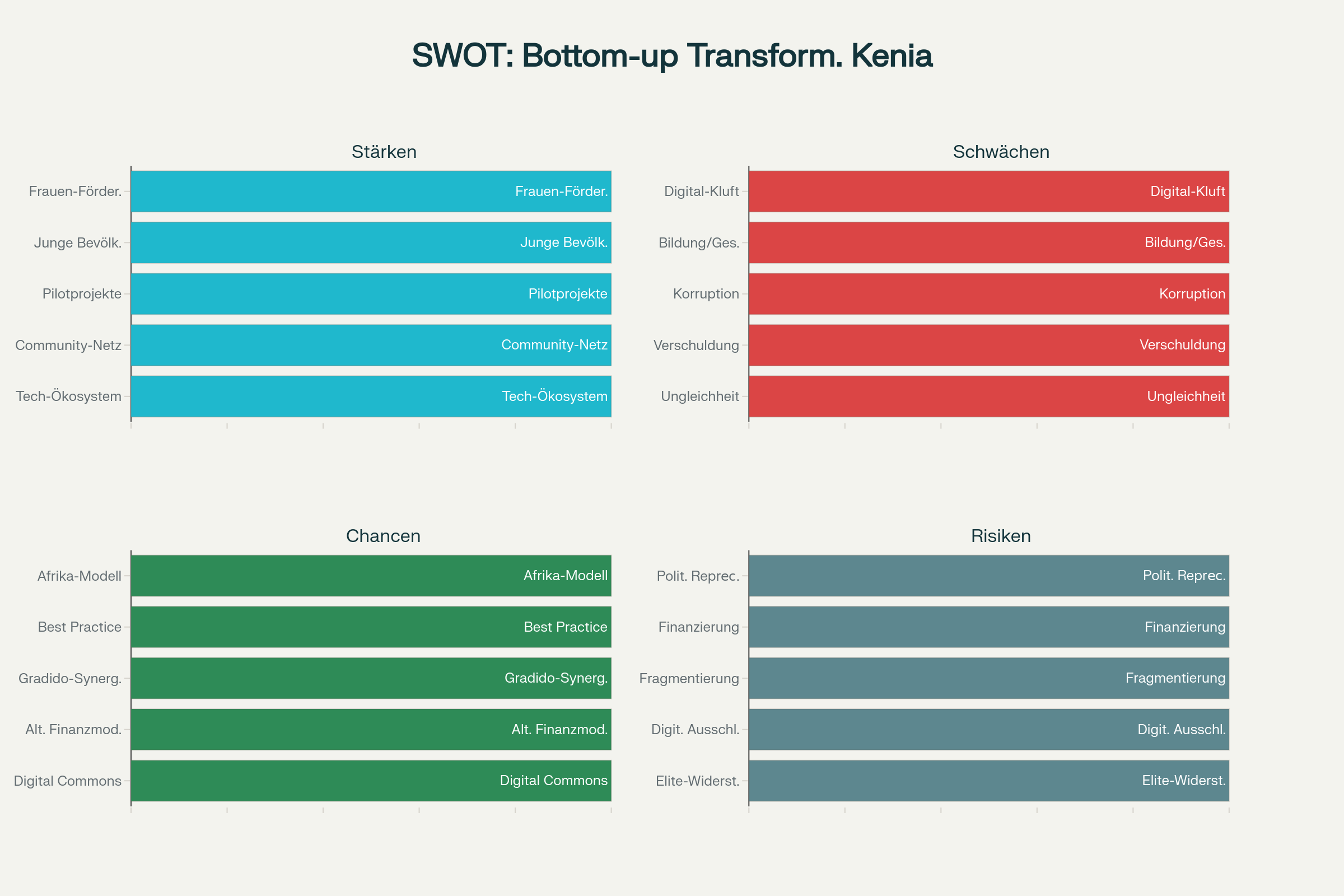
SWOT analysis: Kenya's potential for bottom-up transformation and Gradido model
8 Kenya and Africa as global beacons of hope for change
8.1 From pilot project to global movement
Kenya and other African countries are on the cusp of becoming global beacons of hope for socio-ecological change oriented towards the common good. The unique combination of technological innovation, strong community structures and a willingness to break new ground makes the continent an ideal laboratory for transformative economic and social models.^22^34^38^95
While Western industrialized countries are often held back by established structures and interest groups, African countries can practice „leapfrogging“ - skipping traditional development stages and moving directly to innovative, sustainable solutions. M-Pesa is a prime example of this phenomenon: Kenya has become the global market leader for mobile payments without first having to establish a nationwide banking network.^3^38
8.2 Political, social and cultural success factors
The political openings for civic innovation, the combination of digital transformation with traditional values and the embedding of alternative financial models such as Gradido or Sarafu in local ecosystems - always incorporating the principles of Ubuntu - are crucial.^22^34^95
Political success factors:
Innovation-friendly regulation: Kenya's regulatory sandbox approach enables experimentation with new technologies^3^41
Civil society participation: Strong NGOs and community organizations are driving change from below^15^17^38
DecentralizationCounty governments enable regional pilot projects^17
International partnershipsCooperation with the UN, EU and development policy actors^4^64
Social success factors:
Demographic bonusYoung, education-oriented population as a driver of innovation^5^7
Entrepreneurial culture: High proportion of self-employed and informal economy encourages experimentation^2^41
Social mobilizationExperience with protests and democratic engagement^11^13
Intercultural diversity: Different ethnic groups contribute different perspectives^100
Cultural success factors:
Ubuntu philosophyCommunity orientation as cultural DNA^19^23^22
Oral traditions: Strong culture of storytelling and knowledge transfer^21
Respect for nature: Traditional connection with the natural environment^68^93
Solidarity across generations: Family and clan structures as a social network^25
8.3 Technological success factors
Kenya's technological infrastructure offers ideal conditions for scaling digital economies for the common good:
Mobile penetration: Over 90% of the population have access to cell phones^3^40
M-Pesa infrastructure: Comprehensive mobile payment system as a basis^40
Startup ecosystem: Vibrant tech scene with experienced developers and entrepreneurs^39^40
Open source cultureStrong community and willingness to collaborate^55^86
Innovation Hubs: Physical spaces for networking, learning and co-creation^37^39
International connectivity: Good connection through fiber optic cable and satellite internet^9
8.4 Global appeal of an African prosperity and peace movement
Its international appeal comes from bottom-up initiatives, sustainable networking models and the strong role of women, youth and innovative communities. As a model country, Kenya shows how successful synergies from open source, community currency and Ubuntu can lead to global prosperity and peace movements.^6^20^34^44^75
Global impact potentials:
New narrativesAfrica not as a recipient of aid, but as an innovator and laboratory for the future^34^38
South-South cooperationTransfer of solutions between countries of the Global South without Western intermediaries^36^96
Alternative to capitalismDemonstration that economies oriented towards the common good can work and create prosperity^22^71
Ecological transformation: Combining social justice and environmental protection as a role model^68^93
Digital sovereigntyOpen Source as a path to technological independence^55^86
PeacebuildingCommunity-based economic models as an alternative to resource conflicts^16^22
Vision for 2030:
Kenya could become a beacon for alternative economic models by 2030, in which:
5 million people actively participate in Gradido communities^75
50% of care work is recognized through public benefit points^23^90
1,000 local economic cycles form resilient regional economies^50
Open source technologies contribute to 80% of the digital infrastructure^56^55
Ubuntu values are integrated into education systems and corporate culture^19^92
The ecological footprint is reduced by 30% through incentivized sustainability^93^75
Starting in Kenya, this movement could spread to the entire African continent and eventually globally, driven by the vision: Global prosperity, peace and freedom in harmony with nature.^69^95^75
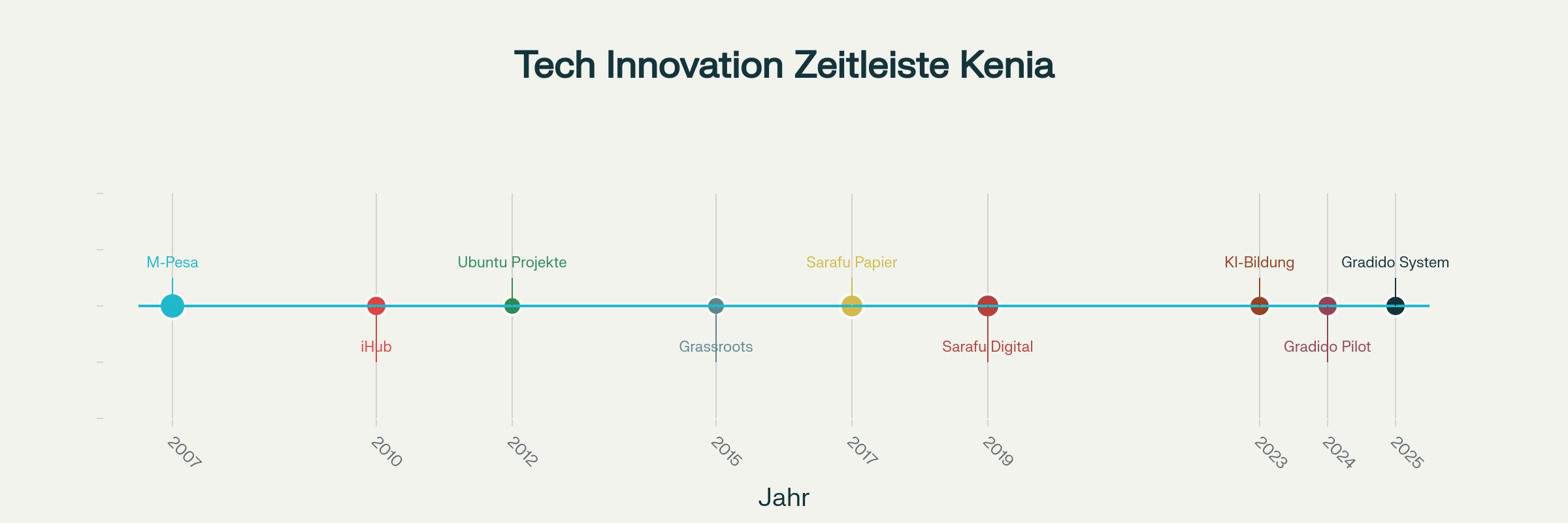
Timeline: Milestones - Kenya's grassroots innovation momentum (2007-2025)
Conclusion and outlook
Kenya combines a young, innovative population, strong community traditions and a dynamic tech scene with a growing awareness of alternative economic models and social transformation. The social opening for bottom-up processes, synergies of Gradido, Open Source and Ubuntu as well as the practical experiences with community currencies and empowerment show: Kenya has the potential to become a model and beacon of hope for African and global change.^6^22^39^49^53^95
The successful pilot projects with Sarafu demonstrate that community currencies work, increase income and strengthen social cohesion. The vibrant tech scene with initiatives such as iHub, Moringa School and She Code Africa shows that technological innovation and social inclusion can go hand in hand. The Ubuntu philosophy provides the cultural framework for community-based economic models that are based on cooperation rather than competition.^19^22^24^43^45^53
Concrete recommendations for action
For Gradido initiators:
Building partnerships with Grassroots Economics, iHub and other established players^37^49
Start pilot projects in 2-3 communities (urban/rural mix)^26^30
Adapt technology to local conditions (USSD, offline functions)^49^58
Conduct training-of-trainers programs with local multipliers^64^89
For Kenyan communities:
Use existing structures (chamas, cooperatives) as a starting point^28^26
Organize workshops on alternative economic models^92
For international supporters:
Provide funding for pilot projects (without creating dependencies)^4^64
Supporting technical expertise and open source development^55^86
Promoting policy work for favorable framework conditions^17
Creating media attention for positive narratives from Africa^34^36
Need for research
Further research is required for successful implementation and scaling:
Comparative studiesComparison of different community currency models (Sarafu, Gradido, others)^49^51
Impact assessmentLong-term evaluation of the socio-economic effects^51^53
Technology researchOptimizing the digital infrastructure for African contexts^55^57
Cultural studies research: Deeper analysis of the link between Ubuntu and alternative economies^21^23
Policy researchDevelopment of a legal framework for community currencies^10^41
Final vision
The next steps should lie in the stronger networking of initiatives, training-of-trainers for Gradido and community apps, and in participatory research. Experiences and best practices from Kenya can significantly enrich the global debate on the common good, peace and freedom - and thus open up new ways of achieving prosperity and participation in harmony with people and nature worldwide.^22^64^69^75^92^95
Kenya shows the world: a different economy is possible - an economy that is based on cooperation rather than competition, that values care work, that respects ecological boundaries, that combines technological innovation with social inclusion, and that gives everyone the opportunity to contribute to the prosperity of all through work for the common good.^69^73^90
From the slums of Nairobi to the rural communities on Lake Victoria, from the tech hubs of Silicon Savannah to the women's cooperatives in Mombasa - the seeds of a new economic order are being planted everywhere. An order that serves life, not profit. An order based on Ubuntu: I am because we are.^19^25^28^40^22
This vision is not a utopia, but a realistic perspective, supported by millions of people who are already proving that change is possible. Gradido, Open Source and Ubuntu are not just concepts, but tools for this transformation. Kenya can be the catalyst that brings these tools to global impact.^6^34^53^71^86^22
The future begins in Africa. The future starts now. The future is us - together.^36
